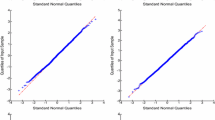Abstract
Three Mixed Proportional Hazard models for estimation of unemployment duration when attrition is present are considered. The virtue of these models is that they take account of dependence between failure times in a multivariate failure time distribution context. However, identification in dependent competing risks models is not straightforward. We show that these models, independently derived, are special cases of a general frailty model. It is also demonstrated that the three models are identified by means of identification of the general model. An empirical example illustrates the approach to model dependent failure times.
Similar content being viewed by others
References
A. Han and J. Hausman, “Flexible parametric estimation of duration and competing risk models,”Journal of Applied Econometrics, vol. 5 pp. 325–353, 1990.
J. J. Heckman and B. E. Honoré, “The identifiability of the competing risks model,”Biometrika, vol. 76:2 pp. 325–330, 1989.
J. J. Heckman and B. L. Singer, “A method for minimizing the impact of distributional assumptions in econometric models for duration data,”Econometrica, vol. 52 pp. 271–320, 1984.
P. Hougaard, “Survival models for heterogeneous populations derived from stable distributions,”Biometrika, vol. 73:2 pp. 387–396, 1986a.
P. Hougaard, “A class of multivariate failure time distributions,”Biometrika, vol. 73:3 pp. 671–678, 1986b.
P. Hougaard, “Modelling Multivariate Survival,”Scandinavian Journal of Statistics, vol. 14 pp. 291–304, 1987.
N. M. Kiefer, “Economic duration data and hazard functions,”Journal of Economic Literature, vol. 26 pp. 646–679, 1988.
T. Lancaster, “Econometric methods for the duration of unemployment,”Econometrica, vol. 47 pp. 936–956, 1979.
T. Lancaster,The econometric analysis of transition data Cambridge University Press: Cambridge, 1990.
M. Lindeboom and G. Van Den Berg, “Heterogeneity in Models for Bivariates: the Importance of the Mixing Distribution,”Journal of the Royal Statistical Society, vol. 56 pp. 49–60, 1994.
B. Meyer, “Unemployment insurance and unemployment spells,”Econometrica, vol. 58 pp. 757–782, 1990.
W. Narendranathan and M. B. Stewart, “Modelling the Probability of Leaving Unemployment: Competing Risks Models with Flexible Baseline Hazards,”Applied Statistics, vol. 42 pp. 63–83, 1993.
G. J. Van Den Berg, M. Lindeboom, and G. Ridder, “Attrition in Longitudinal Panel Data, and the Empirical Analysis of Dynamic Labour Market Behaviour,”Journal of Applied Econometrics, 1994, in press.
Author information
Authors and Affiliations
Rights and permissions
About this article
Cite this article
Carling, K., Jacobson, T. Modeling unemployment duration in a dependent competing risks framework: Identification and estimation. Lifetime Data Anal 1, 111–122 (1995). https://doi.org/10.1007/BF00985262
Received:
Accepted:
Issue Date:
DOI: https://doi.org/10.1007/BF00985262



